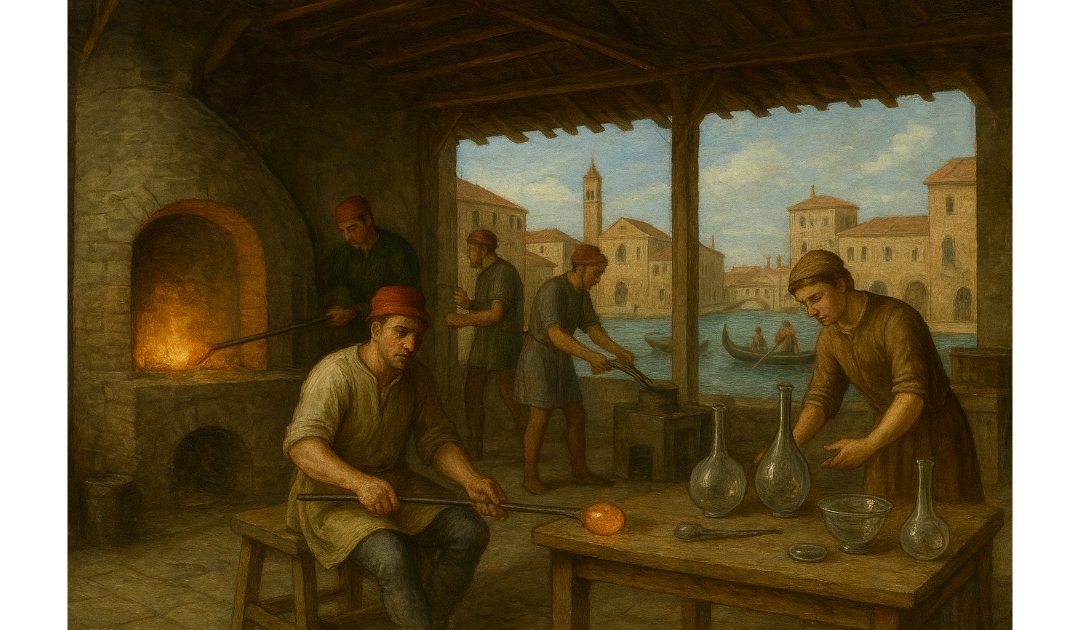Wikipedia tells me that on the 8th of November, 1291, the Republic of Venice enacted a law that confined most of Venice’s glassmakers to the island of Murano. Venice features as a setting in Fire and Earth, the second book in the Sir Anthony Standen Adventures.
Murano is a small island located in the Venetian Lagoon, just north of Venice, renowned for its centuries-old tradition of glassmaking. Its history is deeply intertwined with that of Venice, reflecting the city’s rise as a prosperous maritime republic and its enduring legacy in the arts and crafts.
Murano’s prominence began in the late 13th century, when the Venetian government, concerned about frequent fires in the wooden city caused by glass furnaces, ordered all glassmakers to move their workshops to Murano in 1291. This decree not only reduced the risk of devastating fires in Venice but also created an environment where glass artisans could work in relative isolation. This isolation was strategic: Venice wanted to maintain its monopoly on glassmaking techniques, and restricting the artisans to Murano made it easier to guard these secrets.
By the 14th and 15th centuries, Murano had become the epicentre of glass production in Europe. The island’s craftsmen developed pioneering techniques that made its glass highly sought after across the continent. Among their many innovations were crystalline glass, enamelled glass (smalto), glass with threads of gold (aventurine), multicoloured glass (millefiori), and imitation gemstones. Murano glassmakers also perfected the technique of producing mirrors, which became a luxury item across Europe and a lucrative source of income for the Venetian Republic.
The glassmakers of Murano were granted special privileges by the Venetian government in recognition of their importance to the city’s economy. They were considered part of the aristocracy, allowed to carry swords and enjoy immunity from certain prosecutions. However, there was a trade-off: glassmakers were forbidden to leave Venice in order to prevent the spread of their secrets. Despite this, some artisans did escape to other countries, helping to establish glassmaking industries in places like France and Bohemia.
During the Renaissance, Murano’s glass reached a peak of prestige. Its elegant goblets, chandeliers, and decorative pieces were prized by nobles and royalty. The island became a symbol of refinement and craftsmanship, and collectors throughout Europe sought its wares. The Commedia dell’Arte and other aspects of Venetian culture often featured Murano glass as a signifier of wealth and taste.
The fortunes of Murano’s glass industry, however, were tied to the broader fate of the Venetian Republic. By the 17th and 18th centuries, competition from other European glassmakers and the gradual decline of Venice’s political and economic power led to a reduction in Murano’s influence. The Industrial Revolution further challenged its traditional methods, as mass-produced glass could be made more cheaply elsewhere. Yet, Murano’s artisans maintained their dedication to handcraftsmanship, ensuring that their products retained a sense of artistry that mass production could not replicate.
The 19th century brought a revival. As interest in historic crafts and artisanal techniques grew, Murano glass experienced a renaissance. Artists and entrepreneurs looked to the island’s rich heritage, reintroducing historic styles and developing new ones that celebrated Venice’s cultural legacy. One notable figure in this revival was Antonio Salviati, who promoted Murano glass internationally and helped establish its reputation as a collectible and decorative art form.
Today, Murano’s glassmaking tradition continues, blending respect for history with modern innovation. Workshops on the island still produce intricate chandeliers, sculptures, jewellery, and decorative pieces. Visitors can witness artisans at work, shaping molten glass with techniques that have been passed down for generations. The island is not just a tourist destination but also a living museum of Venetian heritage, where the echoes of medieval guilds and Renaissance workshops still resonate.

